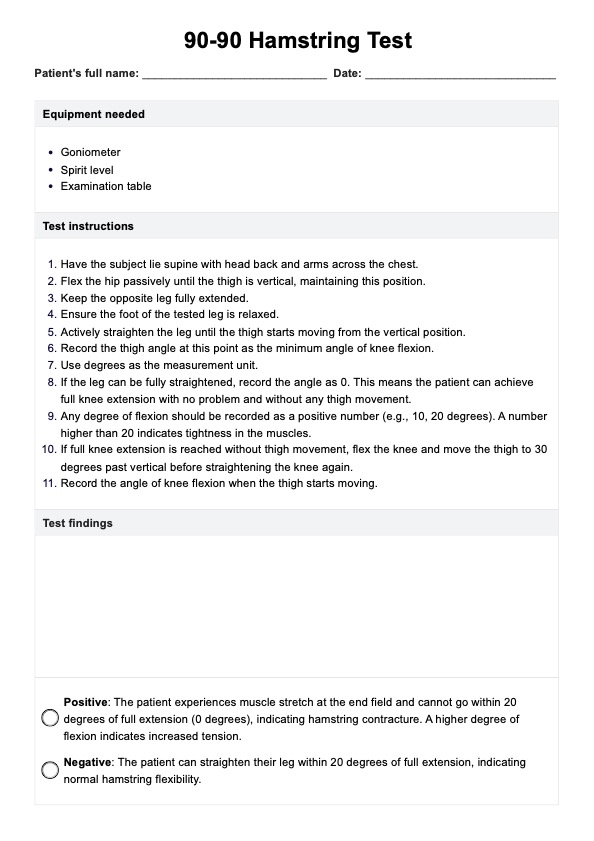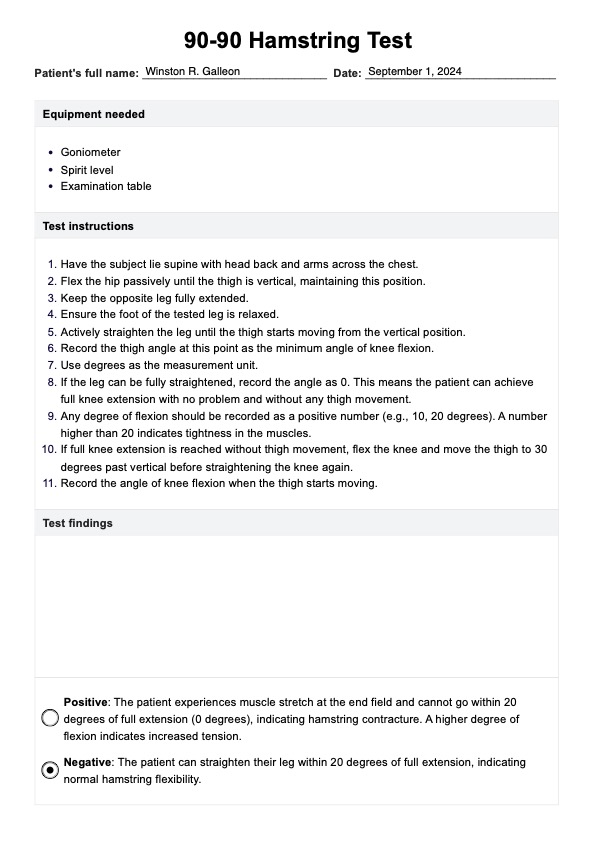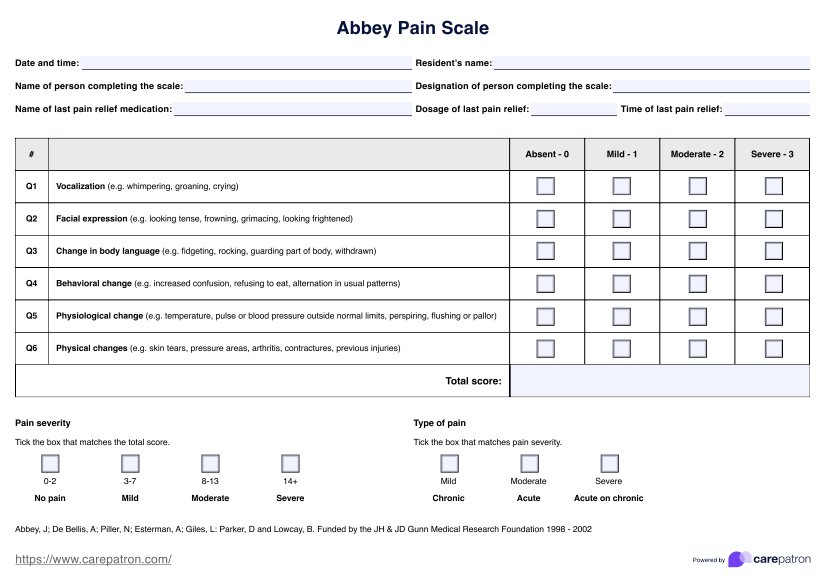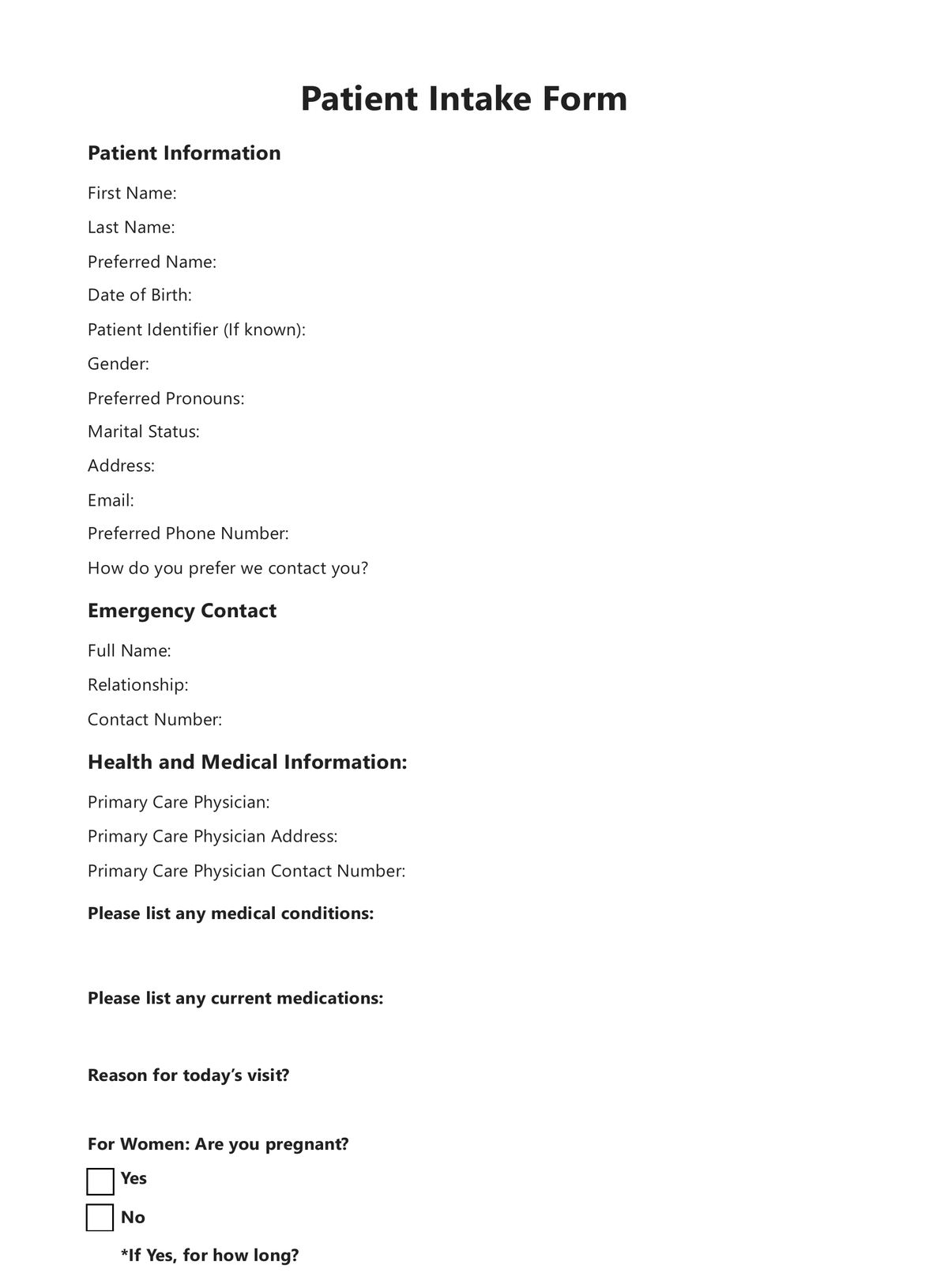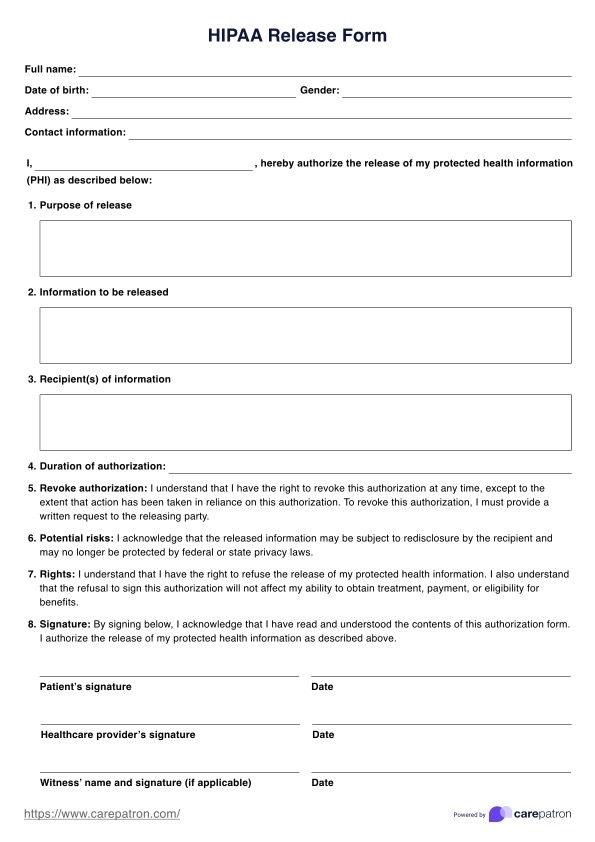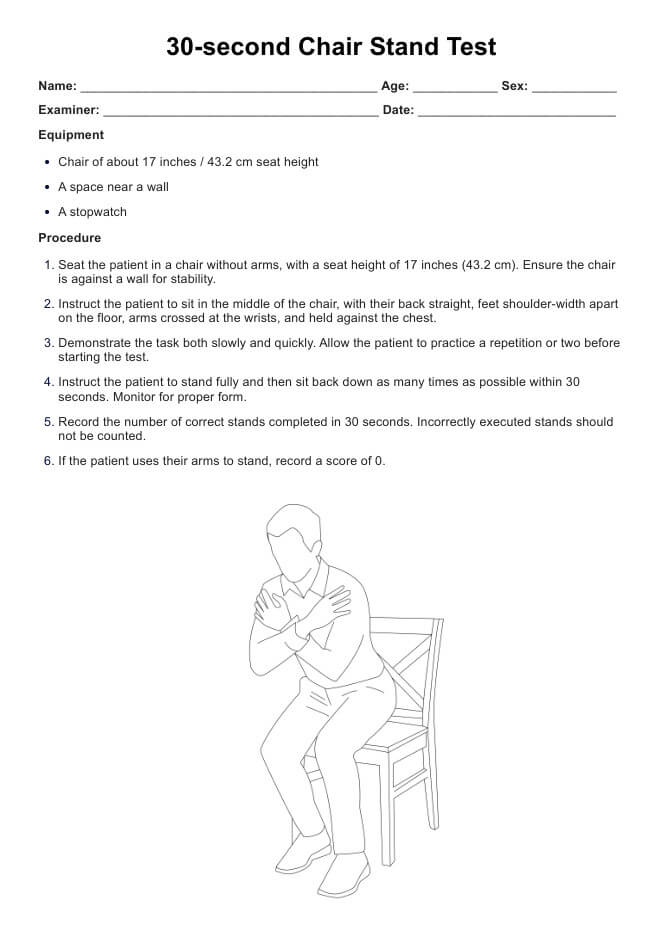90-90 Hamstring Test
Learn how to perform the 90-90 Hamstring Test. Access a free PDF template and example here.


An introduction to hamstrings and their functions
The hamstrings are a group of three muscles at the back of the thigh: biceps femoris, semitendinosus, and semimembranosus. They originate from the ischial tuberosity (the bony prominence at the bottom of the pelvis). They are inserted into various parts of the tibia and fibula bones in the lower leg.
The hamstrings, a group of three muscles located at the back of the thigh, are not just muscles but key players in the body's movement. Their primary function is to flex the knee joint and extend the hip joint, enabling the performance of everyday activities like walking, running, and jumping. They also contribute to stabilizing the knee joint and aiding in rotational movements of the leg, making them crucial for mobility and agility.
In addition to their crucial role in lower body movement, the hamstrings are essential for maintaining proper posture. Hamstring tightness or weakness can contribute to postural imbalances and lead to issues such as lower back pain.
90-90 Hamstring Test Template
90-90 Hamstring Test Example
What is a hamstring contracture?
One condition that can affect the hamstrings is hamstring contracture. This refers to a tightening or shortening of the hamstrings, which can significantly limit our flexibility and range of motion. It's important to know that various factors, including muscle imbalances, repetitive strain injuries, and inadequate stretching, can cause this condition.
Individuals at a higher risk for developing hamstring contractures include athletes who frequently engage in activities requiring explosive movements, such as sprinting or jumping, and those with a sedentary lifestyle.
Symptoms of hamstring contractures may include difficulty straightening the leg completely, pain and discomfort in the upper thigh and back of the knee, and limited movement and hip flexion.
What is the 90-90 Hamstring Test?
The 90-90 Hamstring Test, also known as the active knee extension test, is a widely recognized method within sports medicine and physical therapy to measure hamstring muscle tightness and overall hamstring length. This method is considered highly effective for evaluating the flexibility of the hamstring muscles, which is one of the critical aspects of athletic training and injury prevention.
In conjunction with other assessments, like a passive knee extension test, this assessment can provide valuable information about the tightness and flexibility of the hamstrings in healthy adults. The 90-90 Hamstring Test can also help identify muscle imbalances between the hamstrings and quadriceps.
How is this test conducted?
To measure hamstring flexibility during the 90-90 Hamstring Test, the subject should be lying in a supine position, lying down with their head tilted back and arms crossed on the chest. The hip is gently bent until the thigh is perpendicular while the other leg is fully stretched and resting, maintaining a straight leg. The foot of the tested leg should remain relaxed.
Next, the examiner actively extends the leg until the thigh starts to move from its perpendicular position to measure the knee extension angle. This angle is noted as the minimum degree of knee flexion. If full knee extension occurs without thigh movement, the knee is bent, and the thigh is moved 30 degrees past perpendicular before straightening the knee again to assess knee flexion.
Any level of flexion is recorded as a positive value (e.g., 10, 20 degrees), while full knee extension is noted as 0 degrees. Normal values of hamstring muscle length fall between 0 to 20 degrees.
Interpreting the results
As mentioned, any level of flexion measured is recorded as a positive value, with zero degrees indicating the ability to achieve full knee extension without any thigh movement. The higher the degree of knee flexion, the more flexible the hamstring muscles are. On the other hand, a lower degree of knee flexion indicates tightness in these muscles.
Our 90-90 Hamstring Test template lists all the steps the examiner needs to take to conduct this test effectively and successfully. As for using the template itself, all they need to do is indicate clerical details (e.g., the patient's name, the examiner's name, the date the test was conducted, etc.), what their findings are, and any additional notes they have (e.g., what the next steps are based on their findings).
It's important to note that while this test is highly reliable and valid, it should not be used as the sole measure of hamstring flexibility. Other factors, such as muscle strength and overall joint mobility, also play a role in determining an individual's physical capabilities.
Benefits of using our 90-90 Hamstring Test template
Our 90-90 Hamstring Test template offers numerous benefits to both healthcare professionals and their patients:
Fully digital
Our digital template makes it easy to access and use on any device. This eliminates physical paperwork and allows efficient storage of 90-90 Hamstring Test documentation and results.
Standardized assessment
With our template, healthcare professionals can ensure they are following a standardized procedure when performing the 90-90 Hamstring Test. This helps to increase the reliability and accuracy of results.
Time-efficient
Using our template can save time for both healthcare professionals and their patients. The form is easy to fill out, with clear instructions and areas to input information, making the assessment process quicker and more efficient.
Customizable
Our template allows for customization based on individual patient needs. Healthcare professionals can add or remove sections as needed, making it a versatile tool for various patients and situations.
Commonly asked questions
The 90-90 Hamstring Test helps assess the hamstrings' flexibility and range of motion. It can also identify imbalances between the left and right sides.
The test is generally considered safe, but proper technique and not pushing beyond one's limits are essential to avoid potential strains or injuries.
The frequency of the test can vary depending on individual needs and goals. The healthcare professional conducting the test will and should be able to determine the most appropriate frequency for a person's specific situation.
While the 90-90 Hamstring Test primarily focuses on the hamstrings' flexibility and range of motion, it can also indirectly assess the ipsilateral hip and knee extensors. These muscles work together to provide stability and support during the test. Any imbalances or limitations in hamstring flexibility may indicate potential issues with these muscle groups.


